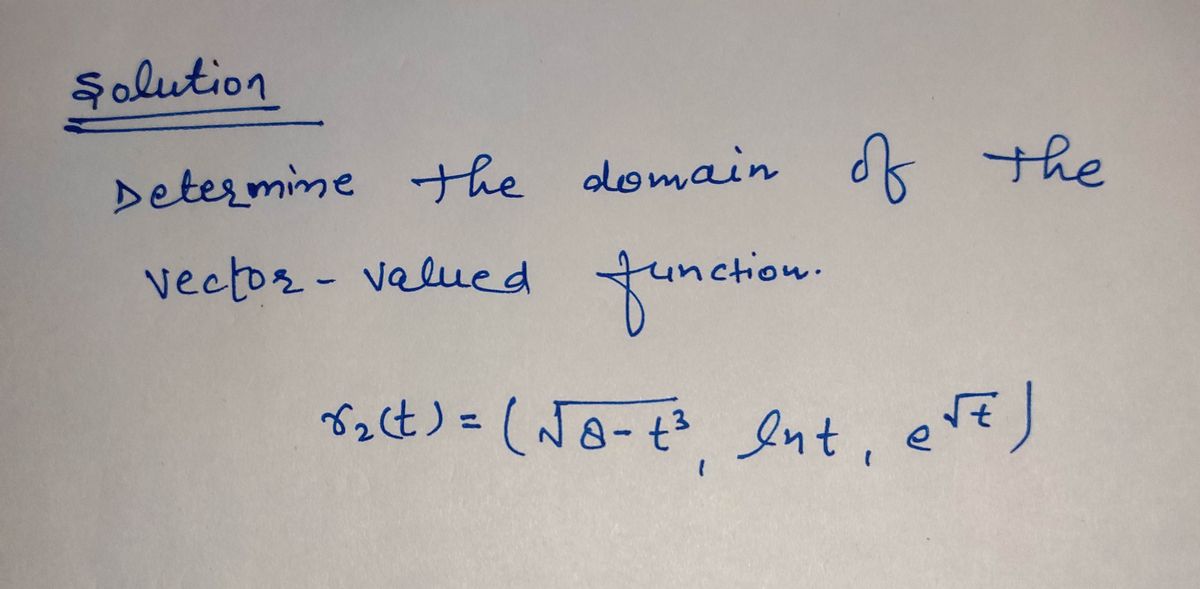Calculus: Early Transcendentals
8th Edition
ISBN:9781285741550
Author:James Stewart
Publisher:James Stewart
Chapter1: Functions And Models
Section: Chapter Questions
Problem 1RCC: (a) What is a function? What are its domain and range? (b) What is the graph of a function? (c) How...
Related questions
Question
![**Problem 2: Determine the Domains of the Vector-Valued Function**
Given the vector-valued function:
\[
\mathbf{r}_2(t) = \left\langle \sqrt{8 - t^3}, \ln t, e^{\sqrt{t}} \right\rangle
\]
**Explanation:**
To find the domain of the vector-valued function \(\mathbf{r}_2(t)\), we must consider the domain restrictions for each component of the vector:
1. **Square Root Component \(\sqrt{8 - t^3}\):**
- The expression under the square root, \(8 - t^3\), must be non-negative.
- Therefore, \(8 - t^3 \geq 0\).
- Solving for \(t\), we get \(t^3 \leq 8\), which implies \(t \leq 2\).
2. **Logarithmic Component \(\ln t\):**
- The argument of the logarithm, \(t\), must be positive.
- Therefore, \(t > 0\).
3. **Exponential Component \(e^{\sqrt{t}}\):**
- The base of the exponent is valid for all real numbers, but the square root requires \(t\) to be non-negative.
- Thus, \(t \geq 0\).
**Overall Domain:**
By combining these conditions, the domain for \(\mathbf{r}_2(t)\) is \(0 < t \leq 2\).
The entire function is defined for the intersection of the domains of its components, where \(t\) is strictly greater than zero and less than or equal to two.](/v2/_next/image?url=https%3A%2F%2Fcontent.bartleby.com%2Fqna-images%2Fquestion%2F93c425ca-5be8-4a48-b5f2-917fc035445e%2F7b5721a0-4246-435a-bb25-8d1ae80ad702%2F8m523l8n_processed.png&w=3840&q=75)
Transcribed Image Text:**Problem 2: Determine the Domains of the Vector-Valued Function**
Given the vector-valued function:
\[
\mathbf{r}_2(t) = \left\langle \sqrt{8 - t^3}, \ln t, e^{\sqrt{t}} \right\rangle
\]
**Explanation:**
To find the domain of the vector-valued function \(\mathbf{r}_2(t)\), we must consider the domain restrictions for each component of the vector:
1. **Square Root Component \(\sqrt{8 - t^3}\):**
- The expression under the square root, \(8 - t^3\), must be non-negative.
- Therefore, \(8 - t^3 \geq 0\).
- Solving for \(t\), we get \(t^3 \leq 8\), which implies \(t \leq 2\).
2. **Logarithmic Component \(\ln t\):**
- The argument of the logarithm, \(t\), must be positive.
- Therefore, \(t > 0\).
3. **Exponential Component \(e^{\sqrt{t}}\):**
- The base of the exponent is valid for all real numbers, but the square root requires \(t\) to be non-negative.
- Thus, \(t \geq 0\).
**Overall Domain:**
By combining these conditions, the domain for \(\mathbf{r}_2(t)\) is \(0 < t \leq 2\).
The entire function is defined for the intersection of the domains of its components, where \(t\) is strictly greater than zero and less than or equal to two.
Expert Solution
Step 1

Step by step
Solved in 2 steps with 2 images

Recommended textbooks for you

Calculus: Early Transcendentals
Calculus
ISBN:
9781285741550
Author:
James Stewart
Publisher:
Cengage Learning

Thomas' Calculus (14th Edition)
Calculus
ISBN:
9780134438986
Author:
Joel R. Hass, Christopher E. Heil, Maurice D. Weir
Publisher:
PEARSON

Calculus: Early Transcendentals (3rd Edition)
Calculus
ISBN:
9780134763644
Author:
William L. Briggs, Lyle Cochran, Bernard Gillett, Eric Schulz
Publisher:
PEARSON

Calculus: Early Transcendentals
Calculus
ISBN:
9781285741550
Author:
James Stewart
Publisher:
Cengage Learning

Thomas' Calculus (14th Edition)
Calculus
ISBN:
9780134438986
Author:
Joel R. Hass, Christopher E. Heil, Maurice D. Weir
Publisher:
PEARSON

Calculus: Early Transcendentals (3rd Edition)
Calculus
ISBN:
9780134763644
Author:
William L. Briggs, Lyle Cochran, Bernard Gillett, Eric Schulz
Publisher:
PEARSON

Calculus: Early Transcendentals
Calculus
ISBN:
9781319050740
Author:
Jon Rogawski, Colin Adams, Robert Franzosa
Publisher:
W. H. Freeman


Calculus: Early Transcendental Functions
Calculus
ISBN:
9781337552516
Author:
Ron Larson, Bruce H. Edwards
Publisher:
Cengage Learning